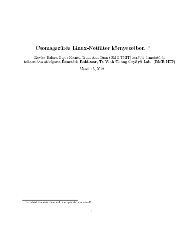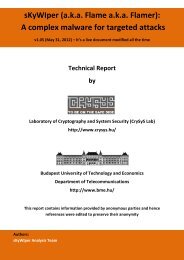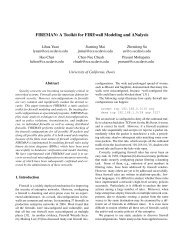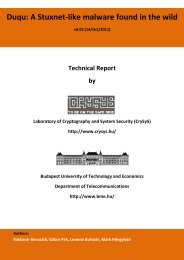You also want an ePaper? Increase the reach of your titles
YUMPU automatically turns print PDFs into web optimized ePapers that Google loves.
Algorithm 1 Optimal branching factor generating algorithm<br />
f(B, d)<br />
if ∑ (B) > d then<br />
exit (no solution exists)<br />
else<br />
find B ′ ⊆ B such that<br />
∏ (B ′ ) + ∑ (B \ B ′ ) ≤ d and ∏ (B ′ ) is maximal<br />
end if<br />
if B ′ = B then<br />
return ( ∏ (B ′ ))<br />
else<br />
return ∏ (B ′ )|f(B \ B ′ , d − ∏ (B ′ ))<br />
end if<br />
2.3. Optimal trees in case of single member compromise<br />
Theorem 2. Let N and Dmax be the total number of members and the upper bound on the<br />
maximum authentication delay, respectively. Moreover, let B be a vector that contains the prime<br />
factors of N. Then, f(B, Dmax) is an optimal branching factor vector for N and Dmax.<br />
Proof. I will give a sketch of the proof. Let B ∗ = f(B, Dmax), and let us assume that there is<br />
another branching factor vector B ′ ̸= B ∗ that also satisfies the constraints of the optimization<br />
problem and R(B ′ ) > R(B ∗ ). I will show that this leads to a contradiction, hence B ∗ should be<br />
optimal.<br />
Let B ∗ = (b ∗ 1, b ∗ 2, . . . , b ∗ ℓ ∗) and B′ = (b ′ 1, b ′ 2, . . . , b ′ ℓ ′). Recall that B∗ is obtained by first maximizing<br />
the first element in the vector, therefore, b ∗ 1 ≥ b ′ 1 must hold. If b ∗ 1 > b ′ 1, then R(B ∗ ) ≥ R(B ′ )<br />
by Lemma 3, and thus, B ′ cannot be a better vector than B ∗ . This means that b ∗ 1 = b ′ 1 must hold.<br />
We know that once b ∗ 1 is determined, the algorithm continues by maximizing the next element<br />
of B ∗ . Hence, b ∗ 2 ≥ b ′ 2 must hold. If b ∗ 2 > b ′ 2, then R(B ∗ ) ≥ R(B ′ ) by Lemma 4, and thus, B ′<br />
cannot be a better vector than B ∗ . This means that b ∗ 2 = b ′ 2 must hold too.<br />
By repeating this argument, finally, we arrive to the conclusion that B ∗ = B ′ must hold, which<br />
is a contradiction. ⋄<br />
Table 2.1 illustrates the operation of the algorithm for B = (5, 5, 5, 3, 3, 3, 2, 2, 2) and d = 90.<br />
The rows of the table correspond to the levels of the recursion during the execution. The column<br />
labeled with B ′ contains the prime factors that are joined at a given recursion level. The optimal<br />
branching factor vector can be read out from the last column of the table (each row contains one<br />
element of the vector). From this example, we can see that the optimal branching factor vector<br />
for N = 27000 and Dmax = 90 is B ∗ = (72, 5, 5, 5, 3). For the key-tree defined by this vector, we<br />
get R ≈ 0.9725, and D = 90.<br />
Table 2.1: Illustration of the operation of the recursive function f when called with B =<br />
(5, 5, 5, 3, 3, 3, 2, 2, 2) and d = 90. The rows of the table correspond to the levels of the recursion<br />
during the execution.<br />
recursion level B d B ′ ∏ (B ′ )<br />
1 (5, 5, 5, 3, 3, 3, 2, 2, 2) 90 (3, 3, 2, 2, 2) 72<br />
2 (5, 5, 5, 3) 18 (5) 5<br />
3 (5, 5, 3) 13 (5) 5<br />
4 (5, 3) 8 (5) 5<br />
5 (3) 3 (3) 3<br />
19












